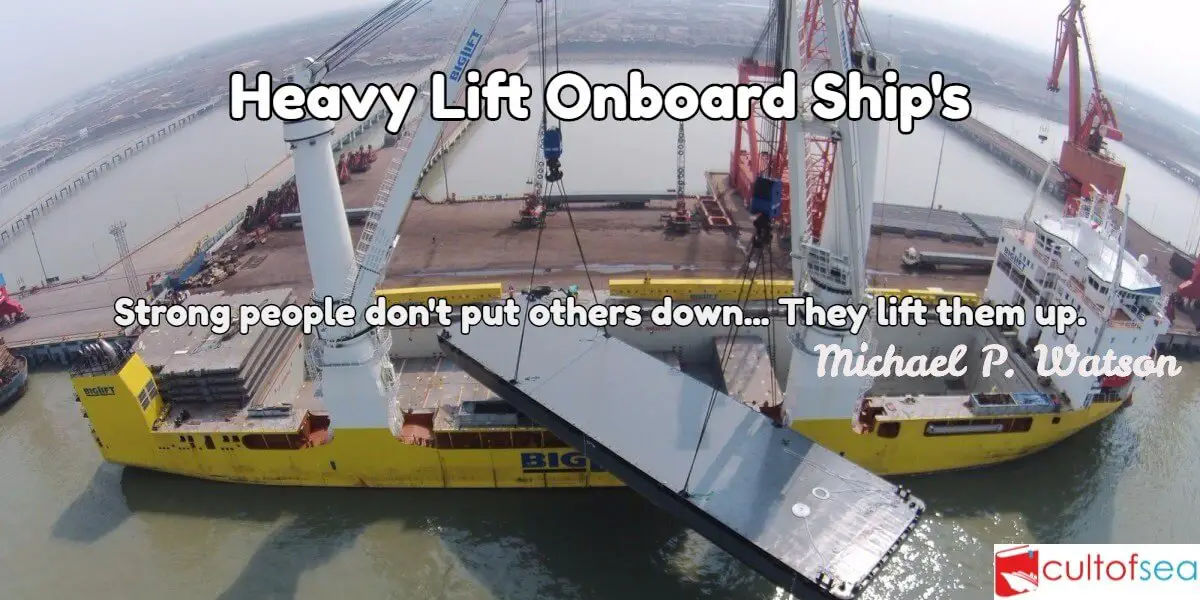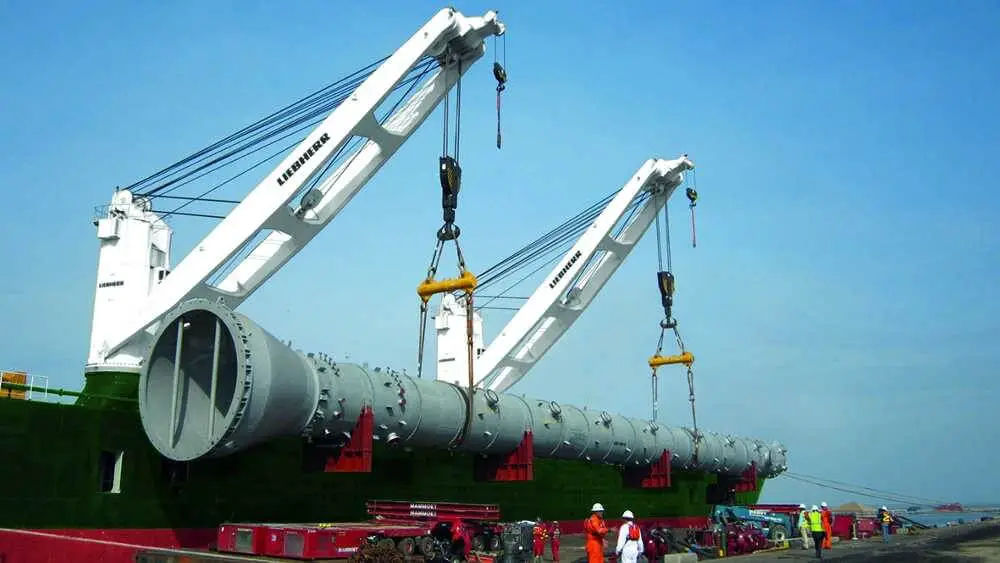Precautions for Heavy Lift Onboard
- Carry out a “Risk Assessment” prior to commencing the operation to ensure that all possible areas of hazard are taken account of and that all risks are at an acceptable, tolerable risk level.
- Ensure that the stability of the vessel is adequate to compensate for the anticipated angle of heel that be experienced when the load at the maximum angle of outreach.
- All free surface elements should be reduced or eliminated, if possible, to ensure a positive value of GM throughout the operation.
- Any additional rigging, such as “preventer backstays” should be secured as per the ships rigging plan.
- A full inspection of all guys, lifting tackles, blocks, shackles and wires should be conducted prior to commencing the lift by the officer-in-charge. All associated equipment should be found to be incorrect order with correct SWL shackles in position and all tackles must be seen to be overhauling.
- Allowance must be made for the weight lifted plus the purchase weight.
- End links ring or shackles to ride freely from whichever point they hang.
- While slinging, wood or other packings to be used to protect the sling from any sharp edges on the load and to prevent the sling from cutting into the load.
- Remove guard rails, if possible.
- Avoid shocks due to load slipping or sudden start.
- Men should be ordered to lift the gangway from the quayside and the ordered to positions of standby, to tend the vessels moorings at the fore and aft stations
- The ships fenders should be rigged to prevent ship contact with the quayside at the moment of heeling.
- Ensure that the deck area, where the weight is to be landed (when loading) is clear of obstructions and the deck plate is laid with timber barriers (heavy dunnage) to spread the weight of the load.
- The ships plans should be consulted to ensure that the limitations of the density plan and deck load capacity is not exceeded.
- Check that the winch drivers are experienced and competent and that all winches are placed into double gear to ensure slow moving operation.
- Release any barges or small boats moored to the shipside before commencing any heavy lift operation.
- Secure steadying lines to the load itself and to any saucer/collar connection fitment attached to the lifting hook.
- Inspect and confirm the lifting points of the load are attached to the load itself and not just secured to any protective casing.
- Ensure that the area is clear of all unnecessary personnel and that the winch drivers are in sight of a single controller.
- Set tight all power guys, and secure the lifting strops to the hook and load respectively.
- When all rigging is considered ready, the weight of the load should be taken to “float the weight clear of the quayside (loading).This vessel will cause the vessel to heel over as the full weight of the load becomes effective at the head of the derrick boom.
- Some lateral drag movement must be anticipated on the load and it is important that the line of plumb is not lost with the ship heeling over.
- Once the load is suspended from the derrick and the chief officer can check that the rigging of the equipment is satisfactory, then the control of the hoist operation can be passed to the hatch controlling foreman.
Assuming that all checks are in order, the chief officer would not normally intervene with the lifting operation being controlled by the hatch foreman, unless something untoward happened which would warrant intervention by the ship’s officer. This is strictly a case of too many cooks could spoil a safe loading operation.
NB: The main duties of the chief officer are to ensure that the vessel has adequate positive stability and this can be improved by filling DB water ballast tanks. Additionally, he should ensure that the derrick is rigged correctly and that all moving parts are operating in a smooth manner.
STABILITY CHANGES – HEAVY LIFTS
If it is realised from the onset that once a heavy lift is taken up by a crane or derrick, the COG of the load is deemed to act from the head of that derrick or crane jib. When calculating the ship’s stability criteria, this assumption is, for all intense and purposes, like loading a weight above the ship’s COG.
Mariners who find themselves involved in ship stability calculations will appreciate that when a weight is loaded on board the vessel, a movement of the ship’s ‘G’ will be in a direction towards the weight being loaded. It, therefore, follows that once a weight is lifted and that weight is effectively acting from the head of the derrick, the ship’s position of ‘G’ will move upwards towards this point of action.
The outcome of the load and causing an upward movement of ‘G’ is to cause G to move towards M (the Metacentre. This action would be to effect a reduction in the ship’s GM Value.
Once the weight of the load is taken by the ship’s derrick, chief officer should appreciate that the ship’s “G” will rise towards ‘M’, probably even rising above ‘M’ causing an unstable condition. It would, therefore, make sense to lower the position of ‘G’, in anticipation of the rising ‘G’ prior to a heavy lift being made.
If the GM can be increased before the lift takes place, i.e. by filling DB tanks, the angle of the heel can be seen to be less.
EFFECT OF HEAVY LIFT ON THE SEAWORTHINESS
- Heavy lift cargoes, when loaded, can have a great effect on the seaworthiness of the vessel.
- Securing of the heavy lift should be done with respect to “Cargo Securing Manual”. Also the “Code for Safe Practice for Cargo Stowage and Securing”.
- If the heavy lift is not secured properly, the cargo may shift during heavy weather which may result in a heavy list at sea and may cause capsizing of the vessel. Also, the heavy lift may cause damage to the vessel’s structure and result into loss of the vessel’s watertight integrity, resulting in flooding/ progress flooding of the vessel.


The following can be the precautions that can be taken care of while lifting a heavy cargo like check the vessel stability, the free surface area can be considered while lifting etc.
All free surface elements should be reduced or eliminated, if possible, to ensure a positive value of GM throughout the operation.